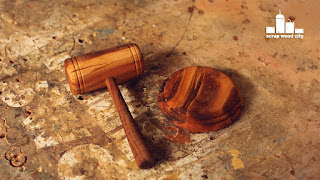I wanted a really large skew chisel for my lathe but those tools can be really expensive. As a result I decided to make a homemade one, out of an old file and a piece of walnut for handle. I used a file because files are made of pretty hard steel.
First of all I used a chalk, to mark the areas of the file, I wanted to remove.
I then used the angle grinder to cut the areas I did not wanted.
I then used my desktop grinder for some rough cleaning with the stone disc.
I then cleaned up the chisel using a belt sander. Since the file was pretty hard steel, I had to change belts quite often.
To clean up difficult areas, I used my rotary tool with a cylindrical stone bit.
I then used a marker to mark the basic bevels of my chisel. I rough shaped the bevel on my belt sander. Because I wanted to avoid hardening the tool, I often dipped the edge in water to avoid burning.
I cut a piece of walnut on the bandsaw to act as my handle.
I used flat chisels and a V carving chisel to cut the groove that would receive the tool’s handle part.
To duplicate the first opening, I sprayed WD40 and kind of printed one wood on the other.
I glued the two pieces together.
After the glue dried, I flattened the edges on my disc sander. I also removed material using my block plane, to save me some time on the lathe.
To turn the handle on the lathe, I glued a piece of wood on the hollowed edge. This way I can mount the piece on the lathe between centers, without ruining my hole.
I used a scraper and a skew chisel to shape the handle. I also cut a metal cylinder with my rotary tool. I measured it’s diameter with a caliper, and used a parting tool to make a cylindrical tenon on my handle to receive it.
I then sanded the piece on the lathe and applied a few coats of wax and olive oil finish, while my handle was still mounted on the lathe.
I then cut of the pieces I didn’t want on the bandsaw.
I used my disc sander to sand the metal cylinder flush.
I glued everything together using two part epoxy. I also used epoxy o fill any remaining gaps.
To sharpen my chisel, I used a flat wooden piece and strips of sandpaper. I used 100, 240, 500, 800, 1000, 2000 grit papers and polished it with leather. I also applied polishing compound on the leather.
At this point my tool was ready. It works pretty nicely and I am really happy with the way it came out. I also learned so many things while making it!
I hope you like it.
























